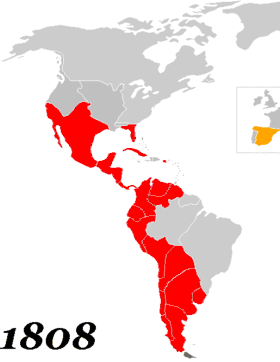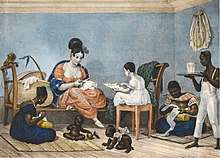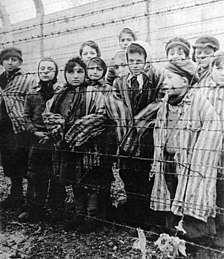Late modern period
In many periodizations of human history, the late modern period followed the early modern period. It began approximately in the mid-18th century and depending on the author either ended with the beginning of contemporary history after World War II, or includes that period up to the present day. Notable historical milestones included the American Revolution, the French Revolution, the Industrial Revolution, the Great Divergence, and the Russian Revolution. It took all of human history up to 1804 for the world's population to reach 1 billion; the next billion came just over a century later, in 1927.[1]
| Part of a series on | |||
| Human history Human Era | |||
|---|---|---|---|
| ↑ Prehistory (Pleistocene epoch) | |||
| Holocene | |||
|
|
|||
| Ancient | |||
|
|
|||
| Postclassical | |||
|
|
|||
| Modern | |||
|
|||
| ↓ Future | |||
Major events
As a result of the Industrial Revolution and political revolutions in the early modern period, the world-views of modernism emerged. The industrialization of many nations was initiated with the industrialization of the Kingdom of Great Britain. Particular facets of the late modern period include:
- Increasing role of science and technology
- Spread of social movements
- Institution of representative democracy
- The abolition of slavery
- New Imperialism and the Scramble for Africa, and later decolonization
- Industrialization
- Urbanization
- Increasing role of medicine and sanitation
- Mass literacy and proliferation of mass media
- Women's rights
- Socialism and the Cold War
- Demographic transition
- Green Revolution in agriculture
- Information Age in the latter 20th and the early 21st century
Other important events in the development of the Late modern period include:
- The Opium Wars and Unequal Treaties in China (c. mid-19th century)
- The failed Revolutions of 1848 in Europe
- The development of the telegraph (c. late 18th century) and the adoption of Morse code (c. mid-19th century)
- The American Civil War (1860–1865) and the abolition of slavery in the US (1863–1865)
- The Meiji Restoration in Japan (c. 1868)
- The Franco-Prussian War (1870–1871), the Unification of Germany (1871), and the Unification of Italy (1871)
- The Congress of Berlin, of 1878 and the subsequent Scramble for Africa.
- The development of radio telecommunication (c. 1894)
- The Spanish–American War and the American annexation of the Philippines
- The First World War (1914–1918) and the fall of the Austro-Hungarian and Ottoman Empires
- The Sykes–Picot Agreement (1916) between the British and French empires create the modern boundaries of Syria and Iraq
- The Russian Revolution (1917) and the Russian Civil War (1917–1922)
- The Turkish War of Independence (1919–1922); the Greek (1913–1922), Armenian (1914–1923), and Assyrian (1914–1924) genocides
- The March on Rome and the rise of Fascism in Italy (1922)
- The Great Depression (1929 – late 1930s) worldwide and the New Deal in the US
- The failed Beer Hall Putsch (1925) and the Hitler's rise to power in Germany (1931–1933)
- The Soviet famine (1932–1933), including the Holodomor in Soviet Ukraine and the Kazakh famine in Soviet Kazakhstan.
- The Japanese invasion of Manchuria (1931) and the Second Sino-Japanese War (1937–1945)
- The Second World War (1939–1945) and the Holocaust in Nazi-occupied Europe (1941–1945)
- The Founding of the United Nations (1945) as a successor to the League of Nations (1920–1946)
- The Bengal Famine (1943) and the Partition of India from the British Empire (1947)
- The Chinese Civil War (beginning 1927) and the Chinese Communist Revolution (1945–1949)
- The Cold War (1947–1991) (including Berlin Blockade (1948–1949), the Korean War (1950–1953), the Hungarian Uprising (1956), the Cuban Revolution (1953–1959) and Cuban Missile Crisis (1962), the Vietnam War (1955–1975), the Prague Spring in Czechoslovakia (1968), and the Soviet-Afghan War (1979–1989))
- De-Stalinization (c. mid-1950s) and the Khrushchev Thaw (c. 1950s-early 1960s) in the Soviet Union, and subsequent Sino-Soviet split (1956–1966)
- The Great Leap Forward campaign (1958–1962), the subsequent Great Chinese Famine (1959–1961), and the Cultural Revolution (1966–1976) in China
- Bangladesh Genocide (1971) and Bangladesh War of Independence from Pakistan (1971)
- The Six-Day War (1967) and the Yom Kippur War (1973) in Israel, and the subsequent OPEC oil embargo against Western countries (1973)
- The Cambodian genocide (1975–1979)
- The Islamic Revolution in Iran (1979), and the Iran–Iraq War (1980–1988)
- Iraqi invasion of Kuwait (1990) and the Persian Gulf War (1990–1991)
- The dissolution of the USSR and the Eastern Bloc (1989–1991), and reunification of West Germany and East Germany (1990)
Timeline

- Dates are approximate range (based upon influence), consult particular article for details
- Modern Age Other
Industrial revolutions

The development of the steam engine started the Industrial Revolution in Great Britain.[2] The steam engine was created to pump water from coal mines, enabling them to be deepened beyond groundwater levels. The date of the Industrial Revolution is not exact, but some studies suggest it occurred after the East India Company's conquests of Mughal Bengal, Kingdom of Mysore and the rest of India, which were already observing the proto-industrialization. Eric Hobsbawm held that it "broke out" in the 1780s and was not fully felt until the 1830s or 1840s,[3] while T.S. Ashton held that it occurred roughly between 1760 and 1830 (in effect the reigns of George III, The Regency, and George IV).[4] The great changes of centuries before the 19th were more connected with ideas, religion or military conquest, and technological advance had only made small changes in the material wealth of ordinary people.
The first Industrial Revolution merged into the Second Industrial Revolution around 1850, when technological and economic progress gained momentum with the development of steam-powered ships and railways, and later in the 19th century with the internal combustion engine and electric power generation. The Second Industrial Revolution was a phase of the Industrial Revolution; labeled as the separate Technical Revolution. From a technological and a social point of view there is no clean break between the two. Major innovations during the period occurred in the chemical, electrical, petroleum, and steel industries. Specific advancements included the introduction of oil fired steam turbine and internal combustion driven steel ships, the development of the airplane, the practical commercialization of the automobile, mass production of consumer goods, the perfection of canning, mechanical refrigeration and other food preservation techniques, and the invention of the telephone.
Industrialization
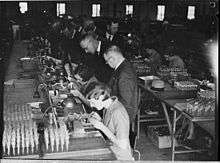
Industrialization is the process of social and economic change whereby a human group is transformed from a pre-industrial society into an industrial one. It is a subdivision of a more general modernization process, where social change and economic development are closely related with technological innovation, particularly with the development of large-scale energy and metallurgy production. It is the extensive organization of an economy for the purpose of manufacturing. Industrialization also introduces a form of philosophical change, where people obtain a different attitude towards their perception of nature.
Revolution in manufacture and power

An economy based on manual labour was replaced by one dominated by industry and the manufacture of machinery. It began with the mechanization of the textile industries and the development of iron-making techniques, and trade expansion was enabled by the introduction of canals, improved roads, and then railways.
The introduction of steam power (fuelled primarily by coal) and powered machinery (mainly in textile manufacturing) underpinned the dramatic increases in production capacity.[5] The development of all-metal machine tools in the first two decades of the 19th century facilitated the manufacture of more production machines for manufacturing in other industries.
The modern petroleum industry started in 1846 with the discovery of the process of refining kerosene from coal by Nova Scotian Abraham Pineo Gesner. Ignacy Łukasiewicz improved Gesner's method to develop a means of refining kerosene from the more readily available "rock oil" ("petr-oleum") seeps in 1852 and the first rock oil mine was built in Bóbrka, near Krosno in Galicia in the following year. In 1854, Benjamin Silliman, a science professor at Yale University in New Haven, was the first to fractionate petroleum by distillation. These discoveries rapidly spread around the world.
Notable engineers

Engineering achievements of the revolution ranged from electrification to developments in materials science. The advancements made a great contribution to the quality of life. In the first revolution, Lewis Paul was the original inventor of roller spinning, the basis of the water frame for spinning cotton in a cotton mill. Matthew Boulton and James Watt's improvements to the steam engine were fundamental to the changes brought by the Industrial Revolution in both the Kingdom of Great Britain and the world.
In the latter part of the second revolution, Thomas Alva Edison developed many devices that greatly influenced life around the world and is often credited with the creation of the first industrial research laboratory. In 1882, Edison switched on the world's first large-scale electrical supply network that provided 110 volts direct current to fifty-nine customers in lower Manhattan. Also toward the end of the second industrial revolution, Nikola Tesla made many contributions in the field of electricity and magnetism in the late 19th and early 20th centuries.
Social effects and classes
The Industrial Revolutions were major technological, socioeconomic, and cultural changes in late 18th and early 19th centuries that began in Britain and spread throughout the world. The effects spread throughout Western Europe and North America during the 19th century, eventually affecting the majority of the world. The impact of this change on society was enormous and is often compared to the Neolithic revolution, when mankind developed agriculture and gave up its nomadic lifestyle.[6]
It has been argued that GDP per capita was much more stable and progressed at a much slower rate until the industrial revolution and the emergence of the modern capitalist economy, and that it has since increased rapidly in capitalist countries.[7]
Mid-19th-century European revolts
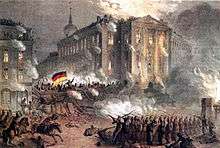
The European Revolutions of 1848, known in some countries as the Spring of Nations or the Year of Revolution, were a series of political upheavals throughout the European continent. Described as a revolutionary wave, the period of unrest began in France and then, further propelled by the French Revolution of 1848, soon spread to the rest of Europe.[8][9] Although most of the revolutions were quickly put down, there was a significant amount of violence in many areas, with tens of thousands of people tortured and killed. While the immediate political effects of the revolutions were reversed, the long-term reverberations of the events were far-reaching.
Industrial age reformism
Industrial age reform movements began the gradual change of society rather than with episodes of rapid fundamental changes. The reformists' ideas were often grounded in liberalism, although they also possessed aspects of utopian, socialist or religious concepts. The Radical movement campaigned for electoral reform, a reform of the Poor Laws, free trade, educational reform, postal reform, prison reform, and public sanitation.
Following the Enlightenment's ideas, the reformers looked to the Scientific Revolution and industrial progress to solve the social problems which arose with the Industrial Revolution. Newton's natural philosophy combined a mathematics of axiomatic proof with the mechanics of physical observation, yielding a coherent system of verifiable predictions and replacing a previous reliance on revelation and inspired truth. Applied to public life, this approach yielded several successful campaigns for changes in social policy.
Imperial Russia

Under Peter the Great, Russia was proclaimed an Empire in 1721 and became recognized as a world power. Ruling from 1682 to 1725, Peter defeated Sweden in the Great Northern War, forcing it to cede West Karelia and Ingria (two regions lost by Russia in the Time of Troubles),[10] as well as Estland and Livland, securing Russia's access to the sea and sea trade.[11] On the Baltic Sea Peter founded a new capital called Saint Petersburg, later known as Russia's Window to Europe. Peter the Great's reforms brought considerable Western European cultural influences to Russia. Catherine II (the Great), who ruled in 1762–96, extended Russian political control over the Polish-Lithuanian Commonwealth and incorporated most of its territories into Russia during the Partitions of Poland, pushing the Russian frontier westward and southward. Russia would colonize the vast Asian lands of Siberia expanding by land to the Pacific Coast of Asia, and North America. As the large realm embraced Absolute Monarchy Russia remained more conservative than its western neighbors. In the 19th century, Russia was invaded by France in 1812 but emerged as a more powerful superpower afterwards. Nonetheless industrialization did not come to Russia until the 1870s. The Medieval practice of serfdom was abolished in 1861 freeing over thirty million Russian peasants. A market economy finally emerged in the Russian Empire. However class warfare rose, and the nation was vulnerable due to rivalries with the United Kingdom, the Ottoman Empire, and the Japanese Empire.
North America
%2C_by_John_Trumbull.jpg)
The French and Indian Wars were a series of conflicts in North America that represented the actions there that accompanied the European dynastic wars. In Quebec, the wars are generally referred to as the Intercolonial Wars. While some conflicts involved Spanish and Dutch forces, all pitted Great Britain, its colonies and American Indian allies on one side and France, its colonies and Indian allies on the other.
The expanding French and British colonies were contending for control of the western, or interior, territories. Whenever the European countries went to war, there were actions within and by these colonies although the dates of the conflict did not necessarily exactly coincide with those of the larger conflicts.
Beginning the Age of Revolution, the American Revolution and the ensuing political upheaval during the last half of the 18th century saw the Thirteen Colonies of North America overthrow the governance of the Parliament of Great Britain, and then reject the British monarchy itself to become the sovereign United States of America. In this period the colonies first rejected the authority of the Parliament to govern them without representation, and formed self-governing independent states. The Second Continental Congress then joined together against the British to defend that self-governance in the armed conflict from 1775 to 1783 known as the American Revolutionary War (also called American War of Independence).
The American Revolution began with fighting at Lexington and Concord. On July 4, 1776, they issued the Declaration of Independence, which proclaimed their independence from Great Britain and their formation of a cooperative union. In June 1776, Benjamin Franklin was appointed a member of the Committee of Five that drafted the Declaration of Independence. Although he was temporarily disabled by gout and unable to attend most meetings of the Committee, Franklin made several small changes to the draft sent to him by Thomas Jefferson.
The rebellious states defeated Great Britain in the American Revolutionary War, the first successful colonial war of independence. While the states had already rejected the governance of Parliament, through the Declaration the new United States now rejected the legitimacy of the monarchy to demand allegiance. The war raged for seven years, with effective American victory, followed by formal British abandonment of any claim to the United States with the Treaty of Paris.
The Philadelphia Convention set up the current United States; the United States Constitution ratification the following year made the states part of a single republic with a limited central government. The Bill of Rights, comprising ten constitutional amendments guaranteeing many fundamental civil rights and freedoms, was ratified in 1791.
European dominance and the 19th century
Historians define the 19th century historical era as stretching from 1815 (the Congress of Vienna) to 1914 (the outbreak of the First World War). Alternatively, Eric Hobsbawm defined the "Long Nineteenth Century" as spanning the years 1789 to 1914.
Imperialism and empires
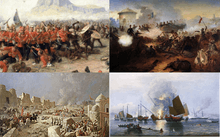
In the 1800s and early 1900s, once great and powerful Empires such as Spain, Ottoman Turkey, the Mughal Empire, and the Kingdom of Portugal began to break apart. Spain, which was at one time unrivaled in Europe, had been declining for a long time when it was crippled by Napoleon Bonaparte's invasion. Sensing the time was right, Spain's vast colonies in South America began a series of rebellions that ended with almost all of the Spanish territories gaining their independence.
The once mighty Ottoman Empire was wracked with a series of revolutions, resulting with the Ottoman's only holding a small region that surrounded the capital, Istanbul.
The Mughal empire, which was descended from the Mongol Khanate, was bested by the upcoming Maratha Confederacy. All was going well for the Marathas until the British took an interest in the riches of India and the British ended up ruling not just the boundaries of Modern India, but also Pakistan, Burma, Nepal, Bangladesh and some Southern Regions of Afghanistan.
The King of Portugal's vast territory of Brazil reformed into the independent Empire of Brazil. With the defeat of Napoleonic France, Britain became undoubtedly the most powerful country in the world, and by the end of the First World War controlled a Quarter of the world's population and a third of its surface. However, the power of the British Empire did not end on land, since it had the greatest navy on the planet. Electricity, steel, and petroleum enabled Germany to become a great international power that raced to create empires of its own.
Substantial decolonization of the Americas occurred through various revolutions and wars of independence fought by new countries in the Americans against European colonizers in late 18th and early-to-mid-19th centuries. The Spanish American wars of independence lasted from 1808 until 1829, directly related to the Napoleonic French invasion of Spain. The conflict started with short-lived governing juntas established in Chuquisaca and Quito opposing the composition of the Supreme Central Junta of Seville. When the Central Junta fell to the French, numerous new Juntas appeared all across the Americas, eventually resulting in a chain of newly independent countries stretching from Argentina and Chile in the south, to Mexico in the north. After the death of the king Ferdinand VII, in 1833, only Cuba and Puerto Rico remained under Spanish rule, until the Spanish–American War in 1898. Unlike the Spanish, the Portuguese did not divide their colonial territory in America. The captaincies they created were subdued to a centralized administration in Salvador (later relocated to Rio de Janeiro) which reported directly to the Portuguese Crown until its independence in 1822, becoming the Empire of Brazil.
The Meiji Restoration was a chain of events that led to enormous changes in Japan's political and social structure that was taking a firm hold at the beginning of the Meiji Era which coincided the opening of Japan by the arrival of the Black Ships of Commodore Matthew Perry and made Imperial Japan a great power. Russia and Qing Dynasty China failed to keep pace with the other world powers which led to massive social unrest in both empires. The Qing Dynasty's military power weakened during the 19th century, and faced with international pressure, massive rebellions and defeats in wars, the dynasty declined after the mid-19th century.
European powers controlled parts of Oceania, with French New Caledonia from 1853 and French Polynesia from 1889; the Germans established colonies in New Guinea in 1884, and Samoa in 1900. The United States expanded into the Pacific with Hawaii becoming a U.S. territory from 1898. Disagreements between the US, Germany and UK over Samoa led to the Tripartite Convention of 1899.
| Decolonization of the Americas |
|---|
|
British Victorian era

The Victorian era of the United Kingdom was the period of Queen Victoria's reign from June 1837 to January 1901. This was a long period of prosperity for the British people, as profits gained from the overseas British Empire, as well as from industrial improvements at home, allowed a large, educated middle class to develop. Some scholars would extend the beginning of the period—as defined by a variety of sensibilities and political games that have come to be associated with the Victorians—back five years to the passage of the Reform Act 1832. In Britain's "imperial century",[12] victory over Napoleon left Britain without any serious international rival, other than Russia in central Asia. Unchallenged at sea, Britain adopted the role of global policeman, a state of affairs later known as the Pax Britannica, and a foreign policy of "splendid isolation". Alongside the formal control it exerted over its own colonies, Britain's dominant position in world trade meant that it effectively controlled the economies of many nominally independent countries, such as China, Argentina and Siam, which has been generally characterized as "informal empire".[13] Of note during this time was the Anglo-Zulu War, which was fought in 1879 between the British Empire and the Zulu Empire.
British imperial strength was underpinned by the steamship and the telegraph, new technologies invented in the second half of the 19th century, allowing it to control and defend the Empire. By 1902, the British Empire was linked together by a network of telegraph cables, the so-called All Red Line. Growing until 1922, around 13,000,000 square miles (34,000,000 km2) of territory and roughly 458 million people were added to the British Empire.[14][15] The British established colonies in Australia in 1788, New Zealand in 1840 and Fiji in 1872, with much of Oceania becoming part of the British Empire.
French governments and conflicts
The Bourbon Restoration followed the ousting of Napoleon I of France in 1814. The Allies restored the Bourbon Dynasty to the French throne. The ensuing period is called the Restoration, following French usage, and is characterized by a sharp conservative reaction and the re-establishment of the Roman Catholic Church as a power in French politics. The July Monarchy was a period of liberal constitutional monarchy in France under King Louis-Philippe starting with the July Revolution (or Three Glorious Days) of 1830 and ending with the Revolution of 1848. The Second Empire was the Imperial Bonapartist regime of Napoleon III from 1852 to 1870, between the Second Republic and the Third Republic, in France.
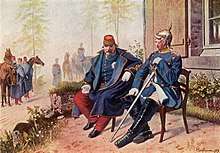
The Franco-Prussian War was a conflict between France and Prussia, while Prussia was backed up by the North German Confederation, of which it was a member, and the South German states of Baden, Württemberg and Bavaria. The complete Prussian and German victory brought about the final unification of Germany under King Wilhelm I of Prussia. It also marked the downfall of Napoleon III and the end of the Second French Empire, which was replaced by the Third Republic. As part of the settlement, almost all of the territory of Alsace-Lorraine was taken by Prussia to become a part of Germany, which it would retain until the end of World War I.
The French Third Republic was the republican government of France between the end of the Second French Empire following the defeat of Louis-Napoléon in the Franco-Prussian war in 1870 and the Vichy Regime after the invasion of France by the German Third Reich in 1940. The Third Republic endured seventy years, making it the most long-lasting regime in France since the collapse of the Ancien Régime in the French Revolution of 1789.
Italian unification

Italian unification was the political and social movement that annexed different states of the Italian peninsula into the single state of Italy in the 19th century. There is a lack of consensus on the exact dates for the beginning and the end of this period, but many scholars agree that the process began with the end of Napoleonic rule and the Congress of Vienna in 1815, and approximately ended with the Franco-Prussian War in 1871, though the last città irredente did not join the Kingdom of Italy until after World War I.
Slavery and abolition
Slavery was greatly reduced around the world in the 19th century. Following a successful slave revolt in Haiti, Britain forced the Barbary pirates to halt their practice of kidnapping and enslaving Europeans, banned slavery throughout its domain, and charged its navy with ending the global slave trade. Slavery was then abolished in Russia(1861), America(1865), and Brazil(1888).
African colonization
Following the abolition of the slave trade in 1807 and propelled by economic exploitation, the Scramble for Africa was initiated formally at the Berlin West Africa Conference in 1884–1885. The Berlin Conference attempted to avoid war among the European powers by allowing the European rival countries to carve up the continent of Africa into national colonies. Africans were not consulted.
The major European powers laid claim to the areas of Africa where they could exhibit a sphere of influence over the area. These claims did not have to have any substantial land holdings or treaties to be legitimate. The European power that demonstrated its control over a territory accepted the mandate to rule that region as a national colony. The European nation that held the claim developed and benefited from their colony's commercial interests without having to fear rival European competition. With the colonial claim came the underlying assumption that the European power that exerted control would use its mandate to offer protection and provide welfare for its colonial peoples, however, this principle remained more theory than practice. There were many documented instances of material and moral conditions deteriorating for native Africans in the late nineteenth and early twentieth centuries under European colonial rule, to the point where the colonial experience for them has been described as "hell on earth."

At the time of the Berlin Conference, Africa contained one-fifth of the world's population living in one-quarter of the world's land area. However, from Europe's perspective, they were dividing an unknown continent. European countries established a few coastal colonies in Africa by the mid-nineteenth century, which included Cape Colony (Great Britain), Angola (Portugal), and Algeria (France), but until the late nineteenth century Europe largely traded with free African states without feeling the need for territorial possession. Until the 1880s most of Africa remained uncharted, with western maps from the period generally showing blank spaces for the continent's interior.
From the 1880s to 1914, the European powers expanded their control across the African continent, competing with each other for Africa's land and resources. Great Britain controlled various colonial holdings in East Africa that spanned the length of the African continent from Egypt in the north to South Africa. The French gained major ground in West Africa, and the Portuguese held colonies in southern Africa. Germany, Italy, and Spain established a small number of colonies at various points throughout the continent, which included German East Africa (Tanganyika) and German Southwest Africa for Germany, Eritrea and Libya for Italy, and the Canary Islands and Rio de Oro in northwestern Africa for Spain. Finally, for King Leopold (ruled from 1865 to 1909), there was the large “piece of that great African cake” known as the Congo, which became his personal fiefdom. By 1914, almost the entire continent was under European control. Liberia, which was settled by freed American slaves in the 1820s, and Abyssinia (Ethiopia) in eastern Africa were the last remaining independent African states.[16]
Meiji Japan
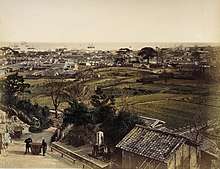
Around the end of the 19th century and into the 20th century, the Meiji era occurred during the reign of the Meiji Emperor. During this time, Japan started its modernization and rose to world power status. This era name means "Enlightened Rule". In Japan, the Meiji Restoration started in the 1860s, marking the rapid modernization by the Japanese themselves along European lines. Much research has focused on the issues of discontinuity versus continuity with the previous Tokugawa Period.[17] It was not until the beginning of the Meiji Era that the Japanese government began taking modernization seriously. Japan expanded its military production base by opening arsenals in various locations. The hyobusho (war office) was replaced with a War Department and a Naval Department. The samurai class suffered great disappointment the following years.
Laws were instituted that required every able-bodied male Japanese citizen, regardless of class, to serve a mandatory term of three years with the first reserves and two additional years with the second reserves. This action, the deathblow for the samurai warriors and their daimyōs, initially met resistance from both the peasant and warrior alike. The peasant class interpreted the term for military service, ketsu-eki ("blood tax") literally, and attempted to avoid service by any means necessary. The Japanese government began modelling their ground forces after the French military. The French government contributed greatly to the training of Japanese officers. Many were employed at the military academy in Kyoto, and many more still were feverishly translating French field manuals for use in the Japanese ranks. Japan's modernized military gave Japan the opportunity to engage in Imperialism with its victory against the Qing Empire in the First Sino-Japanese War Japan annexed Taiwan, Korea and the Chinese province of Shandong.
After the death of the Meiji Emperor, the Taishō Emperor took the throne, the Taishō period was a time of democratic reform granting democratic rights to all Japanese men. Foreigners would be instrumental in aiding in Japan's modernization. A key foreign observer of the remarkable and rapid changes in Japanese society in this period was Ernest Mason Satow.
United States
Antebellum expansion
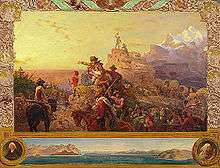
The Antebellum Age was a period of increasing division in the country based on the growth of slavery in the American South and in the western territories of Kansas and Nebraska that eventually led to the Civil War in 1861. The Antebellum Period is often considered to have begun with the Kansas–Nebraska Act of 1854, although it may have begun as early as 1812. This period is also significant because it marked the transition of American manufacturing to the industrial revolution.
"Manifest destiny" was the belief that the United States was destined to expand across the North American continent, from the Atlantic seaboard to the Pacific Ocean. During this time, the United States expanded to the Pacific Ocean—"from sea to shining sea"—largely defining the borders of the contiguous United States as they are today.
Civil War and Reconstruction

The American Civil War began when seven Southern slave states declared their secession from the U.S. and formed the Confederate States of America, the Confederacy (four more states joined the Confederacy later). Led by Jefferson Davis, they fought against the U.S. federal government (the Union) under President Abraham Lincoln, which was supported by all the free states and the five border slave states in the north.
Northern leaders agreed that victory would require more than the end of fighting. Secession and Confederate nationalism had to be totally repudiated and all forms of slavery or quasi-slavery had to be eliminated. Lincoln proved effective in mobilizing support for the war goals, raising large armies and supplying them, avoiding foreign interference, and making the end of slavery a war goal. The Confederacy had a larger area than it could defend, and it failed to keep its ports open and its rivers clear as was the case in the Battle of Vicksburg. The North kept up the pressure as the South could barely feed and clothe its soldiers. Its soldiers, especially those in the East under the command of General Robert E. Lee proved highly resourceful until they finally were overwhelmed by Generals Ulysses S. Grant and William T. Sherman in 1864–65. The Reconstruction Era (1863–77) began with the Emancipation proclamation in 1863, and included freedom, full citizenship and voting rights for Southern blacks. It was followed by a reaction that left the blacks in a second class status legally, politically, socially and economically until the 1960s.
The Gilded Age and legacy
During the Gilded Age, there was substantial growth in population in the United States and extravagant displays of wealth and excess of America's upper-class during the post-Civil War and post-Reconstruction era, in the late 19th century. The wealth polarization derived primarily from industrial and population expansion. The businessmen of the Second Industrial Revolution created industrial towns and cities in the Northeast with new factories, and contributed to the creation of an ethnically diverse industrial working class which produced the wealth owned by rising super-rich industrialists and financiers called the "robber barons". An example is the company of John D. Rockefeller, who was an important figure in shaping the new oil industry. Using highly effective tactics and aggressive practices, later widely criticized, Standard Oil absorbed or destroyed most of its competition.
The creation of a modern industrial economy took place. With the creation of a transportation and communication infrastructure, the corporation became the dominant form of business organization and a managerial revolution transformed business operations. In 1890, Congress passed the Sherman Antitrust Act—the source of all American anti-monopoly laws. The law forbade every contract, scheme, deal, or conspiracy to restrain trade, though the phrase "restraint of trade" remained subjective. By the beginning of the 20th century, per capita income and industrial production in the United States exceeded that of any other country except Britain. Long hours and hazardous working conditions led many workers to attempt to form labor unions despite strong opposition from industrialists and the courts. But the courts did protect the marketplace, declaring the Standard Oil group to be an "unreasonable" monopoly under the Sherman Antitrust Act in 1911. It ordered Standard to break up into 34 independent companies with different boards of directors.[18]
Science and philosophy

Replacing the classical physics in use since the end of the scientific revolution, modern physics arose in the early 20th century with the advent of quantum physics,[19] substituting mathematical studies for experimental studies and examining equations to build a theoretical structure.[20] The old quantum theory was a collection of results which predate modern quantum mechanics, but were never complete or self-consistent.[21] The collection of heuristic prescriptions for quantum mechanics were the first corrections to classical mechanics.[21][22] Outside the realm of quantum physics, the various aether theories in classical physics, which supposed a "fifth element" such as the Luminiferous aether,[23] were nullified by the Michelson–Morley experiment—an attempt to detect the motion of earth through the aether. In biology, Darwinism gained acceptance, promoting the concept of adaptation in the theory of natural selection. The fields of geology, astronomy and psychology also made strides and gained new insights. In medicine, there were advances in medical theory and treatments.
Starting one-hundred years before the 20th century, the enlightenment spiritual philosophy was challenged in various quarters around the 1900s.[24][25][26][27][28][29] Developed from earlier secular traditions,[30] modern Humanist ethical philosophies affirmed the dignity and worth of all people, based on the ability to determine right and wrong by appealing to universal human qualities, particularly rationality, without resorting to the supernatural or alleged divine authority from religious texts.[31][32] For liberal humanists such as Rousseau and Kant, the universal law of reason guided the way toward total emancipation from any kind of tyranny. These ideas were challenged, for example by the young Karl Marx, who criticized the project of political emancipation (embodied in the form of human rights), asserting it to be symptomatic of the very dehumanization it was supposed to oppose. For Friedrich Nietzsche, humanism was nothing more than a secular version of theism. In his Genealogy of Morals, he argues that human rights exist as a means for the weak to collectively constrain the strong. On this view, such rights do not facilitate emancipation of life, but rather deny it. In the 20th century, the notion that human beings are rationally autonomous was challenged by the concept that humans were driven by unconscious irrational desires.
Notable persons

Sigmund Freud is renowned for his redefinition of sexual desire as the primary motivational energy of human life, as well as his therapeutic techniques, including the use of free association, his theory of transference in the therapeutic relationship, and the interpretation of dreams as sources of insight into unconscious desires.
Albert Einstein is known for his theories of special relativity and general relativity. He also made important contributions to statistical mechanics, especially his mathematical treatment of Brownian motion, his resolution of the paradox of specific heats, and his connection of fluctuations and dissipation. Despite his reservations about its interpretation, Einstein also made contributions to quantum mechanics and, indirectly, quantum field theory, primarily through his theoretical studies of the photon.
Social Darwinism
At the end of the 19th century, Social Darwinism was promoted and included the various ideologies based on a concept that competition among all individuals, groups, nations, or ideas was a "natural" framework for social evolution in human societies. In this view, society's advancement is dependent on the "survival of the fittest", the term was in fact coined by Herbert Spencer and referred to in "The Gospel of Wealth" written by Andrew Carnegie.
Marxist society
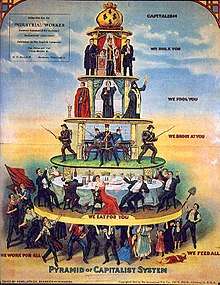
Karl Marx summarized his approach to history and politics in the opening line of the first chapter of The Communist Manifesto (1848). He wrote:
- The history of all hitherto existing society is the history of class struggles.[33]
The Manifesto went through a number of editions from 1872 to 1890; notable new prefaces were written by Marx and Engels for the 1872 German edition, the 1882 Russian edition, the 1883 German edition, and the 1888 English edition. In general, Marxism identified five (and one transitional) successive stages of development in Western Europe.[34]
- Primitive Communism: as seen in cooperative tribal societies.
- Slave Society: which develops when the tribe becomes a city-state. Aristocracy is born.
- Feudalism: aristocracy is the ruling class. Merchants develop into capitalists.
- Capitalism: capitalists are the ruling class, who create and employ the true working class.
- Dictatorship of the proletariat: workers gain class consciousness, overthrow the capitalists and take control over the state.
- Communism: a classless and stateless society.
European decline and the 20th century

Major political developments saw the former British Empire lose most of its remaining political power over commonwealth countries.[35] The Trans-Siberian Railway, crossing Asia by train, was complete by 1916. Other events include the Israeli–Palestinian conflict, two world wars, and the Cold War.
Australian Constitution
In 1901, the Federation of Australia was the process by which the six separate British self-governing colonies of New South Wales, Queensland, South Australia, Tasmania, Victoria and Western Australia formed one nation. They kept the systems of government that they had developed as separate colonies but also would have a federal government that was responsible for matters concerning the whole nation. When the Constitution of Australia came into force, the colonies collectively became states of the Commonwealth of Australia.
Revolution and Warlords in China
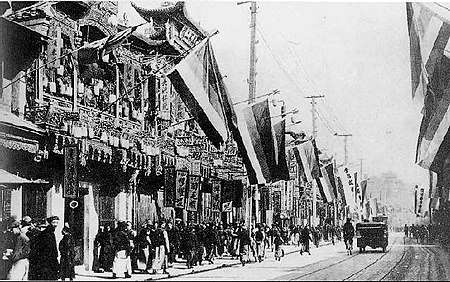
The last days of the Qing dynasty were marked with civil unrest, failed reforms and foreign invasions such as the Boxer rebellion. Responding to these civil failures and discontent, the Qing Imperial Court did attempt to reform the government in various ways, as the decision to draft a constitution in 1906, the establishment of provincial legislatures in 1909, and the preparation for a national parliament in 1910. However, many of these measures were opposed by the conservatives of the Qing Court, and many reformers were either imprisoned or executed outright. The failures of the Imperial Court to enact such reforming measures of political liberalization and modernization caused the reformists to steer toward the road of revolution.
The assertions of Chinese philosophy[36] began to integrate concepts of Western philosophy, as steps toward modernization. By the time of the Xinhai Revolution in 1911, there were many calls, such as the May Fourth Movement, to completely abolish the old imperial institutions and practices of China. There were attempts to incorporate democracy, republicanism, and industrialism into Chinese philosophy, notably by Sun Yat-sen at the beginning of the 20th century
In 1912, the Republic of China was established and Sun Yat-sen was inaugurated in Nanjing as the first Provisional President. But power in Beijing already had passed to Yuan Shikai, who had effective control of the Beiyang Army, the most powerful military force in China at the time. To prevent civil war and possible foreign intervention from undermining the infant republic, leaders agreed to Army's demand that China be united under a Beijing government. On March 10, in Beijing, Shikai was sworn in as the second Provisional President of the Republic of China.
After the early 20th century revolutions, shifting alliances of China's regional warlords waged war for control of the Beijing government. Despite the fact that various warlords gained control of the government in Beijing during the warlord era, this did not constitute a new era of control or governance, because other warlords did not acknowledge the transitory governments in this period and were a law unto themselves. These military-dominated governments were collectively known as the Beiyang government. The warlord era ended around 1927.[37]
Start of the 20th century
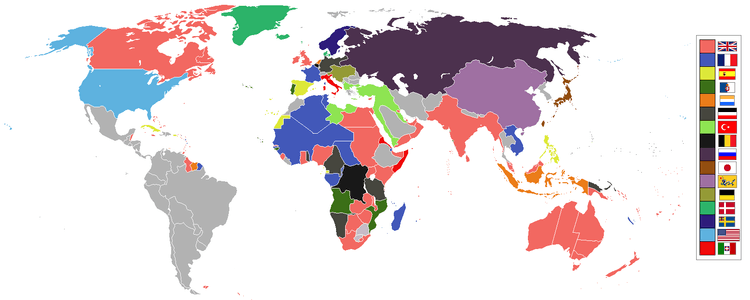
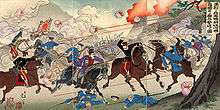
In 1900 the World's Population had approached approximately 1.6 billion. Four years into the 20th century saw the Russo-Japanese War with the Battle of Port Arthur establishing the Empire of Japan as a world power. The Russians were in constant pursuit of a warm water port on the Pacific Ocean, for their navy as well as for maritime trade. The Manchurian Campaign of the Russian Empire was fought against the Japanese over Manchuria and Korea. The major theatres of operations were Southern Manchuria, specifically the area around the Liaodong Peninsula and Mukden, and the seas around Korea, Japan, and the Yellow Sea. The resulting campaigns, in which the fledgling Japanese military consistently attained victory over the Russian forces arrayed against them, were unexpected by world observers. These victories, as time transpired, would dramatically transform the distribution of power in East Asia, resulting in a reassessment of Japan's recent entry onto the world stage. The embarrassing string of defeats increased Russian popular dissatisfaction with the inefficient and corrupt Tsarist government.
The Russian Revolution of 1905 was a wave of mass political unrest through vast areas of the Russian Empire. Some of it was directed against the government, while some was undirected. It included terrorism, worker strikes, peasant unrests, and military mutinies. It led to the establishment of the limited constitutional monarchy,[38] the establishment of State Duma of the Russian Empire, and the multi-party system.
In China, the Qing Dynasty was overthrown following the Xinhai Revolution. The Xinhai Revolution began with the Wuchang Uprising on October 10, 1911, and ended with the abdication of Emperor Puyi on February 12, 1912. The primary parties to the conflict were the Imperial forces of the Qing dynasty (1644–1911), and the revolutionary forces of the Chinese Revolutionary Alliance (Tongmenghui).
Edwardian Britain
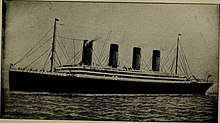
The Edwardian era in the United Kingdom is the period spanning the reign of King Edward VII up to the end of the First World War, including the years surrounding the sinking of the RMS Titanic. In the early years of the period, the Second Boer War in South Africa split the country into anti- and pro-war factions. The imperial policies of the Conservatives eventually proved unpopular and in the general election of 1906 the Liberals won a huge landslide. The Liberal government was unable to proceed with all of its radical programme without the support of the House of Lords, which was largely Conservative. Conflict between the two Houses of Parliament over the People's Budget led to a reduction in the power of the peers in 1910. The general election in January that year returned a hung parliament with the balance of power held by Labour and Irish Nationalist members.
World War I
The causes of World War I included many factors, including the conflicts and antagonisms of the four decades leading up to the war. The Triple Entente was the name given to the loose alignment between the United Kingdom, France, and Russia after the signing of the Anglo-Russian Entente in 1907. The alignment of the three powers, supplemented by various agreements with Japan, the United States, and Spain, constituted a powerful counterweight to the Triple Alliance of Germany, Austria-Hungary, and Italy, the third having concluded an additional secret agreement with France effectively nullifying her Alliance commitments. Militarism, alliances, imperialism, and nationalism played major roles in the conflict. The immediate origins of the war lay in the decisions taken by statesmen and generals during the July Crisis of 1914, the spark (or casus belli) for which was the assassination of Archduke Franz Ferdinand of Austria.
However, the crisis did not exist in a void; it came after a long series of diplomatic clashes between the Great Powers over European and colonial issues in the decade prior to 1914 which had left tensions high. The diplomatic clashes can be traced to changes in the balance of power in Europe since 1870. An example is the Baghdad Railway which was planned to connect the Ottoman Empire cities of Konya and Baghdad with a line through modern-day Turkey, Syria and Iraq. The railway became a source of international disputes during the years immediately preceding World War I. Although it has been argued that they were resolved in 1914 before the war began, it has also been argued that the railroad was a cause of the First World War.[39] Fundamentally the war was sparked by tensions over territory in the Balkans. Austria-Hungary competed with Serbia and Russia for territory and influence in the region and they pulled the rest of the great powers into the conflict through their various alliances and treaties. The Balkan Wars were two wars in South-eastern Europe in 1912–1913 in the course of which the Balkan League (Bulgaria, Montenegro, Greece, and Serbia) first captured Ottoman-held remaining part of Thessaly, Macedonia, Epirus, Albania and most of Thrace and then fell out over the division of the spoils, with incorporation of Romania this time.

Allied powers and areas
Central powers and colonies or occupied territory
Neutral countries
The First World War began in 1914 and lasted to the final Armistice in 1918. The Allied Powers, led by the British Empire, France, Russia until March 1918, Japan and the United States after 1917, defeated the Central Powers, led by the German Empire, Austro-Hungarian Empire and the Ottoman Empire. The war caused the disintegration of four empires—the Austro-Hungarian, German, Ottoman, and Russian ones—as well as radical change in the European and West Asian maps. The Allied powers before 1917 are referred to as the Triple Entente, and the Central Powers are referred to as the Triple Alliance.
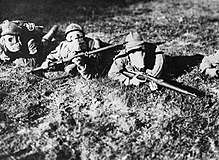
Much of the fighting in World War I took place along the Western Front, within a system of opposing manned trenches and fortifications (separated by a "No man's land") running from the North Sea to the border of Switzerland. On the Eastern Front, the vast eastern plains and limited rail network prevented a trench warfare stalemate from developing, although the scale of the conflict was just as large. Hostilities also occurred on and under the sea and—for the first time—from the air. More than 9 million soldiers died on the various battlefields, and nearly that many more in the participating countries' home fronts on account of food shortages and genocide committed under the cover of various civil wars and internal conflicts. Notably, more people died of the worldwide influenza outbreak at the end of the war and shortly after than died in the hostilities. The unsanitary conditions engendered by the war, severe overcrowding in barracks, wartime propaganda interfering with public health warnings, and migration of so many soldiers around the world helped the outbreak become a pandemic.[40]
Ultimately, World War I created a decisive break with the old world order that had emerged after the Napoleonic Wars, which was modified by the mid-19th century's nationalistic revolutions. The results of World War I would be important factors in the development of World War II approximately 20 years later. More immediate to the time, the partitioning of the Ottoman Empire was a political event that redrew the political boundaries of West Asia. The huge conglomeration of territories and peoples formerly ruled by the Sultan of the Ottoman Empire was divided into several new nations.[41] The partitioning brought the creation of the modern Arab world and the Republic of Turkey. The League of Nations granted France mandates over Syria and Lebanon and granted the United Kingdom mandates over Mesopotamia and Palestine (which was later divided into two regions: Palestine and Transjordan). Parts of the Ottoman Empire on the Arabian Peninsula became parts of what are today Saudi Arabia and Yemen.
Revolutions and war in Eurasia

The Russian Revolution is the series of revolutions in Russia in 1917, which destroyed the Tsarist autocracy and led to the creation of the Soviet Union. Following the abdication of Nicholas II of Russia, the Russian Provisional Government was established. In October 1917, a red faction revolution occurred in which the Red Guard, armed groups of workers and deserting soldiers directed by the Bolshevik Party, seized control of Saint Petersburg (then known as Petrograd) and began an immediate armed takeover of cities and villages throughout the former Russian Empire.
Another action in 1917 that is of note was the armistice signed between Russia and the Central Powers at Brest-Litovsk.[42] As a condition for peace, the treaty by the Central Powers conceded huge portions of the former Russian Empire to Imperial Germany and the Ottoman Empire, greatly upsetting nationalists and conservatives. The Bolsheviks made peace with the German Empire and the Central Powers, as they had promised the Russian people prior to the Revolution. Vladimir Lenin's decision has been attributed to his sponsorship by the foreign office of Wilhelm II, German Emperor, offered by the latter in hopes that with a revolution, Russia would withdraw from World War I. This suspicion was bolstered by the German Foreign Ministry's sponsorship of Lenin's return to Petrograd. The Western Allies expressed their dismay at the Bolsheviks, upset at:
- the withdrawal of Russia from the war effort,
- worried about a possible Russo-German alliance, and
- galvanized by the prospect of the Bolsheviks making good their threats to assume no responsibility for, and so default on, Imperial Russia's massive foreign loans.[43]

In addition, there was a concern, shared by many Central Powers as well, that the socialist revolutionary ideas would spread to the West. Hence, many of these countries expressed their support for the Whites, including the provision of troops and supplies. Winston Churchill declared that Bolshevism must be "strangled in its cradle".[44]
The Russian Civil War was a multi-party war that occurred within the former Russian Empire after the Russian provisional government collapsed and the Soviets under the domination of the Bolshevik party assumed power, first in Petrograd (St. Petersburg) and then in other places. In the wake of the October Revolution, the old Russian Imperial Army had been demobilized; the volunteer-based Red Guard was the Bolsheviks' main military force, augmented by an armed military component of the Cheka, the Bolshevik state security apparatus. There was an instituted mandatory conscription of the rural peasantry into the Red Army.[45] Opposition of rural Russians to Red Army conscription units was overcome by taking hostages and shooting them when necessary in order to force compliance.[46] Former Tsarist officers were utilized as "military specialists" (voenspetsy),[47] taking their families hostage in order to ensure loyalty.[48] At the start of the war, three-fourths of the Red Army officer corps was composed of former Tsarist officers.[48] By its end, 83% of all Red Army divisional and corps commanders were ex-Tsarist soldiers.[49]

The principal fighting occurred between the Bolshevik Red Army and the forces of the White Army. Many foreign armies warred against the Red Army, notably the Allied Forces, yet many volunteer foreigners fought in both sides of the Russian Civil War. Other nationalist and regional political groups also participated in the war, including the Ukrainian nationalist Green Army, the Ukrainian anarchist Black Army and Black Guards, and warlords such as Ungern von Sternberg. The most intense fighting took place from 1918 to 1920. Major military operations ended on 25 October 1922 when the Red Army occupied Vladivostok, previously held by the Provisional Priamur Government. The last enclave of the White Forces was the Ayano-Maysky District on the Pacific coast. The majority of the fighting ended in 1920 with the defeat of General Pyotr Wrangel in the Crimea, but a notable resistance in certain areas continued until 1923 (e.g., Kronstadt Uprising, Tambov Rebellion, Basmachi Revolt, and the final resistance of the White movement in the Far East).
While the early 1920s was a time of flux for revolutionary Russia and Central Asia, the Union of Soviet Socialist Republics was proclaimed in 1922 as the successor state to the fallen Russian Empire. Revolutionary leader Vladimir Lenin died of natural causes and was succeeded by Joseph Stalin.
The Early Republic of China
In 1917, China declared war on Germany in the hope of recovering its lost province, then under Japanese control. The New Culture Movement occupied the period from 1917 to 1923. Chinese representatives refused to sign the Treaty of Versailles, due to intense pressure from the student protesters and public opinion alike.

The May Fourth Movement helped to rekindle the then-fading cause of republican revolution. In 1917 Sun Yat-sen had become commander-in-chief of a rival military government in Guangzhou in collaboration with southern warlords. Sun's efforts to obtain aid from the Western democracies were ignored, however, and in 1920 he turned to the Soviet Union, which had recently achieved its own revolution. The Soviets sought to befriend the Chinese revolutionists by offering scathing attacks on Western imperialism. But for political expediency, the Soviet leadership initiated a dual policy of support for both Sun and the newly established Chinese Communist Party (CCP).

In early 1927, the Kuomintang-CCP rivalry led to a split in the revolutionary ranks. The CCP and the left wing of the Kuomintang had decided to move the seat of the Nationalist government from Guangzhou to Wuhan. But Chiang Kai-shek, whose Northern Expedition was proving successful, set his forces to destroying the Shanghai CCP apparatus and established an anti-Communist government at Nanjing in April 1927.
Nanjing period in China
The "Nanjing Decade" of 1928–37 was one of consolidation and accomplishment under the leadership of the Nationalists, with a mixed but generally positive record in the economy, social progress, development of democracy, and cultural creativity. Some of the harsh aspects of foreign concessions and privileges in China were moderated through diplomacy.
The 1920s and the Depression
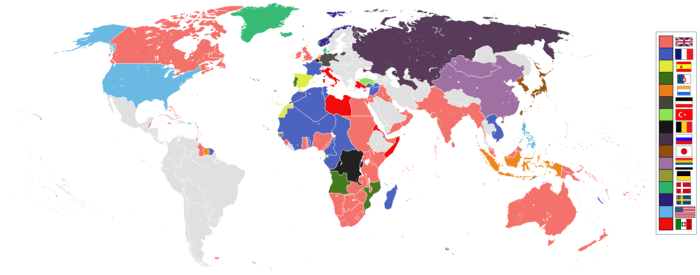
The interwar period was the period between the end of the First World War and the beginning of the Second World War. This period was marked by turmoil in much of the world, as Europe struggled to recover from the devastation of the First World War.

In North America, especially the first half of this period, people experienced considerable prosperity in the Roaring Twenties. The social and societal upheaval known as the Roaring Twenties began in North America and spread to Europe in the aftermath of World War I. The Roaring Twenties, often called "The Jazz Age", saw an exposition of social, artistic, and cultural dynamism. "Normalcy" returned to politics, jazz music blossomed, the flapper redefined modern womanhood, Art Deco peaked. The spirit of the Roaring Twenties was marked by a general feeling of discontinuity associated with modernity, a break with traditions. Everything seemed to be feasible through modern technology. New technologies, especially automobiles, movies and radio proliferated "modernity" to a large part of the population. The 1920s saw the general favor of practicality, in architecture as well as in daily life. The 1920s was further distinguished by several inventions and discoveries, extensive industrial growth and the rise in consumer demand and aspirations, and significant changes in lifestyle.
Europe spent these years rebuilding and coming to terms with the vast human cost of the conflict. The occupation of Istanbul and Izmir in the Ottoman Empire by the Allies in the aftermath of World War I prompted the establishment of the Turkish National Movement. The Turkish War of Independence (1919–1923) was waged with the aim of revoking the terms of the Treaty of Sèvres. After the Turkish victory, the Treaty of Lausanne of 24 July 1923 led to the international recognition of the sovereignty of the newly formed "Republic of Turkey" as the successor state of the Ottoman Empire, and the republic was officially proclaimed on 29 October 1923 in Ankara, the country's new capital. The Lausanne Convention stipulated a population exchange between Greece and Turkey, whereby 1.1 million Greeks left Turkey for Greece in exchange for 380,000 Muslims transferred from Greece to Turkey. The economy of the United States became increasingly intertwined with that of Europe. In Germany, the Weimar Republic gave way to episodes of political and economic turmoil, which culminated with the German hyperinflation of 1923 and the failed Beer Hall Putsch of that same year. When Germany could no longer afford war payments, Wall Street invested heavily in European debts to keep the European economy afloat as a large consumer market for American mass-produced goods. By the middle of the decade, economic development soared in Europe, and the Roaring Twenties broke out in Germany, Britain and France, the second half of the decade becoming known as the "Golden Twenties". In France and francophone Canada, they were also called the "années folles" ("Crazy Years")., 1935. German Nazis created large public performances to earn public support.
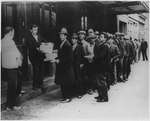
Worldwide prosperity changed dramatically with the onset of the Great Depression in 1929. The Wall Street Crash of 1929 served to punctuate the end of the previous era, as The Great Depression set in. The Great Depression was a worldwide economic downturn starting in most places in 1929 and ending at different times in the 1930s or early 1940s for different countries.[50] It was the largest and most important economic depression in the 20th century, and is used in the 21st century as an example of how far the world's economy can fall.[51]
The depression had devastating effects in virtually every country, rich or poor. International trade plunged by half to two-thirds, as did personal income, tax revenue, prices and profits. Cities all around the world were hit hard, especially those dependent on heavy industry. Construction was virtually halted in many countries. Farming and rural areas suffered as crop prices fell by roughly 60 percent.[52][53][54] Facing plummeting demand with few alternate sources of jobs, areas dependent on primary sector industries suffered the most. The Great Depression ended at different times in different countries with the effect lasting into the next era.[55] America's Great Depression ended in 1941 with America's entry into World War II.[56] The majority of countries set up relief programs, and most underwent some sort of political upheaval, pushing them to the left or right. In some world states, the desperate citizens turned toward nationalist demagogues—the most infamous being Adolf Hitler—setting the stage for the next era of war. The convulsion brought on by the worldwide depression resulted in the rise of Nazism. In Asia, Japan became an ever more assertive power, especially with regards to China.
The League and crises
The interwar period was also marked by a radical change in the international order, away from the balance of power that had dominated pre–World War I Europe. One main institution that was meant to bring stability was the League of Nations, which was created after the First World War with the intention of maintaining world security and peace and encouraging economic growth between member countries.[57]
However the League failed to resolve any major crises and by 1938 it was no longer a major player. The League was undermined by the bellicosity of Nazi Germany, Imperial Japan, the Soviet Union, and Mussolini's Italy, and by the non-participation of the United States.
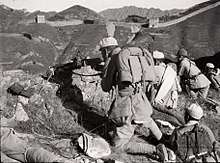
A series of international crises strained the League to its limits, the earliest being the invasion of Manchuria by Japan and the Abyssinian crisis of 1935/36 in which Italy invaded Abyssinia, one of the only free African nations at that time.
The League tried to enforce economic sanctions upon Italy, but to no avail. The incident highlighted French and British weakness, exemplified by their reluctance to alienate Italy and lose her as their ally. The limited actions taken by the Western powers pushed Mussolini's Italy towards alliance with Hitler's Germany anyway. The Abyssinian war showed Hitler how weak the League was and encouraged the remilitarization of the Rhineland in flagrant disregard of the Treaty of Versailles. This was the first in a series of provocative acts culminating in the invasion of Poland in September 1939 and the beginning of the Second World War.
Few Chinese had any illusions about Japanese designs on China. Hungry for raw materials and pressed by a growing population, Japan initiated the seizure of Manchuria in September 1931 and established ex-Qing emperor Puyi as head of the puppet state of Manchukuo in 1932. During the Sino-Japanese War (1937–1945), the loss of Manchuria, and its vast potential for industrial development and war industries, was a blow to the Kuomintang economy. The League of Nations, established at the end of World War I, was unable to act in the face of the Japanese defiance. After 1940, conflicts between the Kuomintang and Communists became more frequent in the areas not under Japanese control. The Communists expanded their influence wherever opportunities presented themselves through mass organizations, administrative reforms, and the land- and tax-reform measures favoring the peasants—while the Kuomintang attempted to neutralize the spread of Communist influence.
Tripartite Pact
The Second Sino-Japanese War had seen tensions rise between Imperial Japan and the United States; events such as the Panay incident and the Nanking Massacre turned American public opinion against Japan. With the occupation of French Indochina in the years of 1940–41, and with the continuing war in China, the United States placed embargoes on Japan of strategic materials such as scrap metal and oil, which were vitally needed for the war effort. The Japanese were faced with the option of either withdrawing from China and losing face or seizing and securing new sources of raw materials in the resource-rich, European-controlled colonies of South East Asia—specifically British Malaya and the Dutch East Indies (modern-day Indonesia). In 1940, Imperial Japan signed the Tripartite Pact with Nazi Germany and Fascist Italy.
World War II

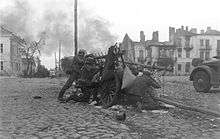
The Second World War was a global military conflict that took place in 1939–1945. It was the largest and deadliest war in history, culminating in the Holocaust and ending with the dropping of the atom bomb.
Even though Japan had been invading in China since 1937, the conventional view is that the war began on September 1, 1939, when Nazi Germany invaded Poland, the Drang nach Osten. Within two days the United Kingdom and France declared war on Germany, even though the fighting was confined to Poland. Pursuant to a then-secret provision of its non-aggression Molotov–Ribbentrop Pact, the Soviet Union joined with Germany on September 17, 1939, to conquer Poland and to divide Eastern Europe. The Allies were initially made up of Poland, the United Kingdom, France, Australia, Canada, New Zealand, South Africa, as well as British Commonwealth countries which were controlled directly by the UK, such as the Indian Empire. All of these countries declared war on Germany in September 1939.
Following the lull in fighting, known as the "Phoney War", Germany invaded western Europe in May 1940. Six weeks later, France, in the meantime, attacked by Italy as well, surrendered to Germany, which then tried unsuccessfully to conquer Britain. On September 27, Germany, Italy, and Japan signed a mutual defense agreement, the Tripartite Pact, and were known as the Axis Powers. Nine months later, on June 22, 1941, Germany launched a massive invasion of the Soviet Union, which promptly joined the Allies. Germany was now engaged in fighting a war on two fronts. This proved to be a mistake by Germany – Germany had not successfully carried out the invasion of Britain and the war turned against the Axis.
On December 7, 1941, Japan attacked the United States at Pearl Harbor, bringing it too into the war on the Allied side. China also joined the Allies, as eventually did most of the rest of the world. China was in turmoil at the time, and attacked Japanese armies through guerilla-type warfare. By the beginning of 1942, the major combatants were aligned as follows: the British Commonwealth, the United States, and the Soviet Union were fighting Germany and Italy; and the British Commonwealth, China, and the United States were fighting Japan. The United Kingdom, the United States, the Soviet Union and China were referred as a "trusteeship of the powerful" during the World War II[58] and were recognized as the Allied "Big Four" in Declaration by United Nations[59] These four countries were considered as the "Four Policemen" or "Four Sheriffs" of the Allies power and primary victors of World War II.[60] From then through August 1945, battles raged across all of Europe, in the North Atlantic Ocean, across North Africa, throughout Southeast Asia, throughout China, across the Pacific Ocean and in the air over Japan. Italy surrendered in September 1943 and was split into a northern Germany-occupied puppet state and an Allies-friendly state in the South; Germany surrendered in May 1945. Following the atomic bombings of Hiroshima and Nagasaki, Japan surrendered, marking the end of the war on September 2, 1945.
It is possible that around 62 million people died in the war; estimates vary greatly. About 60% of all casualties were civilians, who died as a result of disease, starvation, genocide (in particular, the Holocaust), and aerial bombing. The former Soviet Union and China suffered the most casualties. Estimates place deaths in the Soviet Union at around 23 million, while China suffered about 10 million. No country lost a greater portion of its population than Poland: approximately 5.6 million, or 16%, of its pre-war population of 34.8 million died. The Holocaust (which roughly means "burnt whole") was the deliberate and systematic murder of millions of Jews and other "unwanted" during World War II by the Nazi regime in Germany. Several differing views exist regarding whether it was intended to occur from the war's beginning, or if the plans for it came about later. Regardless, persecution of Jews extended well before the war even started, such as in the Kristallnacht (Night of Broken Glass). The Nazis used propaganda to great effect to stir up anti-Semitic feelings within ordinary Germans.
After World War II, Europe was informally split into Western and Soviet spheres of influence. Western Europe later aligned as the North Atlantic Treaty Organization (NATO) and Eastern Europe as the Warsaw Pact. There was a shift in power from Western Europe and the British Empire to the two new superpowers, the United States and the Soviet Union. These two rivals would later face off in the Cold War. In Asia, the defeat of Japan led to its democratization. China's civil war continued through and after the war, resulting eventually in the establishment of the People's Republic of China. The former colonies of the European powers began their road to independence.
Contemporary history - Post-World War II

The mid-20th century is distinguished from most of human history in that its most significant changes were directly or indirectly economic and technological in nature. Economic development was the force behind vast changes in everyday life, to a degree which was unprecedented in human history.
Over the course of the 20th century, the world's per-capita gross domestic product grew by a factor of five,[61] much more than all earlier centuries combined (including the 19th with its Industrial Revolution). Many economists make the case that this understates the magnitude of growth, as many of the goods and services consumed at the end of the 20th century, such as improved medicine (causing world life expectancy to increase by more than two decades) and communications technologies, were not available at any price at its beginning. However, the gulf between the world's rich and poor grew wider,[62] and the majority of the global population remained in the poor side of the divide.[63]
Still, advancing technology and medicine has had a great impact even in the Global South. Large-scale industry and more centralized media made brutal dictatorships possible on an unprecedented scale in the middle of the century, leading to wars that were also unprecedented. However, the increased communications contributed to democratization. Technological developments included the development of airplanes and space exploration, nuclear technology, advancement in genetics, and the dawning of the Information Age.
Pax Americana
Pax Americana is an appellation applied to the historical concept of relative liberal peace in the Western world, resulting from the preponderance of power enjoyed by the United States of America starting around the start of the 20th century. Although the term finds its primary utility in the latter half of the 20th century, it has been used in various places and eras. Its modern connotations concern the peace established after the end of World War II in 1945.
Cold War era
The Cold War began in the mid-1940s and lasted into the early 1990s. Throughout this period, the conflict was expressed through military coalitions, espionage, weapons development, invasions, propaganda, and competitive technological development. The conflict included costly defense spending, a massive conventional and nuclear arms race, and numerous proxy wars; the two superpowers never fought one another directly.
.svg.png)
The Soviet Union created the Eastern Bloc of countries that it occupied, annexing some as Soviet Socialist Republics and maintaining others as satellite states that would later form the Warsaw Pact. The United States and various western European countries began a policy of "containment" of communism and forged myriad alliances to this end, including NATO. Several of these western countries also coordinated efforts regarding the rebuilding of western Europe, including western Germany, which the Soviets opposed. In other regions of the world, such as Latin America and Southeast Asia, the Soviet Union fostered communist revolutionary movements, which the United States and many of its allies opposed and, in some cases, attempted to "roll back". Many countries were prompted to align themselves with the nations that would later form either NATO or the Warsaw Pact, the Non-Aligned Movement emerged from nations who desired neutrality.
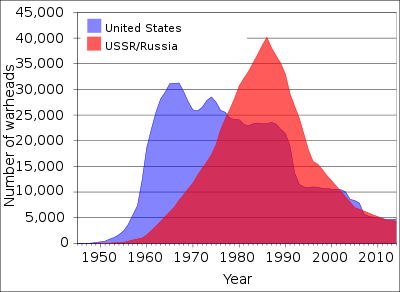
In China Mao Zedong (Máo zé dōng) utilized Marxist-Leninist thought. When the Communist Party of China assumed power in 1949, previous schools of Chinese thought, excepting notably Legalism, were denounced as backward. Many parts of China's past were even purged during the Cultural Revolution. Though initially friendly with the Soviet Union the Chinese and Soviet communists diverged in the Sino-Soviet split of 1960. Through the end of the Cold-War, China would continue on its own path from other communist countries, building better relations with the United States after 1972. China's economy would recover from the Cultural Revolution due to market-oriented reforms led by Deng Xiaoping.
The Cold War saw periods of both heightened tension and relative calm. International crises arose, such as the Berlin Blockade (1948–1949), the Korean War (1950–1953), the Berlin Crisis of 1961, the Vietnam War (1955–1975), the Cuban Missile Crisis (1962), the Soviet–Afghan War (1979–1989) and NATO exercises in November 1983. There were also periods of reduced tension as both sides sought détente. Direct military attacks on adversaries were deterred by the potential for mutual assured destruction using deliverable nuclear weapons.
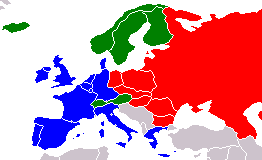 European trade blocs as of the late 1980s. EEC member states are marked in blue, EFTA – green, and Comecon – red. |
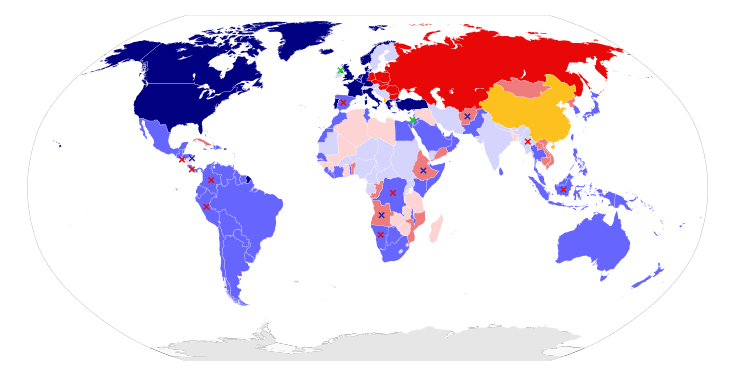 East and West in 1980, as defined by the Cold War. The Cold War had divided Europe politically into East and West, with the Iron Curtain splitting Central Europe. |
The Cold War drew to a close in the late 1980s and the early 1990s. The United States under President Ronald Reagan increased diplomatic, military, and economic pressure on the Soviet Union, which was already suffering from severe economic stagnation. In the second half of the 1980s, newly appointed Soviet leader Mikhail Gorbachev introduced the perestroika and glasnost reforms. The Soviet Union collapsed in 1991, leaving the United States as the dominant military power, though Russia retained much of the massive Soviet nuclear arsenal.
Latin America polarization
In Latin America in the 1970s, leftists acquired a significant political influence which prompted the right-wing, ecclesiastical authorities and a large portion of the individual country's upper class to support coups d'état to avoid what they perceived as a communist threat. This was further fueled by Cuban and United States intervention which led to a political polarization. Most South American countries were in some periods ruled by military dictatorships that were supported by the United States of America. In the 1970s, the regimes of the Southern Cone collaborated in Operation Condor killing many leftist dissidents, including some urban guerrillas.[64] However, by the early 1990s all countries had restored their democracies.
Space Age

The Space Age is a period encompassing the activities related to the Space Race, space exploration, space technology, and the cultural developments influenced by these events. The Space Age began with the development of several technologies that culminated with the launch of Sputnik 1 by the Soviet Union in October 1957. This was the world's first artificial satellite, orbiting the Earth in 98.1 minutes and weighing in at 83 kg. The launch of Sputnik 1 ushered a new era of political, scientific and technological achievements that became known as the Space Age. The Space Age was characterized by rapid development of new technology in a close race mostly between the United States and the Soviet Union. The Space Age brought the first human spaceflight during the Vostok programme and reached its peak with the Apollo program which captured the imagination of much of the world's population. The landing of Apollo 11 on the Moon was an event watched by over 500 million people around the world and is widely recognized as one of the defining moments of the 20th century. Since then, and with the end of the space race due to the dissolution of the Soviet Union, public attention has largely moved to other areas.
Information Age
References
- "World Population to Hit Milestone With Birth of 7 Billionth Person". PBS.org. 2011-10-27. Retrieved 31 July 2017.
- Watt steam engine image: located in the lobby of into the Superior Technical School of Industrial Engineers of the UPM (Madrid)
- Eric Hobsbawm, The Age of Revolution: Europe 1789–1848, Weidenfeld & Nicolson Ltd. ISBN 0-349-10484-0
- Joseph E Inikori. Africans and the Industrial Revolution in England, Cambridge University Press. ISBN 0-521-01079-9.
- Business and Economics. Leading Issues in Economic Development, Oxford University Press US. ISBN 0-19-511589-9.
- Russell Brown, Lester. Eco-Economy, James & James, Earthscan. ISBN 1-85383-904-3.
- Federal Reserve Bank of Minneapolis essay Archived 2007-11-27 at the Wayback Machine retrieved March 11, 2006
- Cayley, E.S. (1856). The European revolutions of 1848. London: Smith, Elder & Co. Vol. I and II.
- Harding, S.B., & Hart, A.B. (1918). New medieval and modern history. New York: American book company.
- Solovyov, S. (2001). History of Russia from the Earliest Times. 9, ch.1. AST. ISBN 978-5-17-002142-0. Retrieved 27 December 2007.
- Solovyov, S. (2001). History of Russia from the Earliest Times. 15, ch.1. AST.
- For more, see Pax Britannica.
- Edwards, B. T. (2004). Informal empire: Mexico and Central America in Victorian culture. Minneapolis, Minn: Univ. of Minnesota Press
- Maddison, Angus (2001). The World Economy: A Millennial Perspective. Organisation for Economic Co-operation and Development. ISBN 92-64-18654-9. pp. 98, 242.
- Ferguson, Niall (2004). Colossus: The Price of America's Empire. Penguin. ISBN 1-59420-013-0. p. 15
- John Merriman, A History of Modern Europe, Volume Two: From the French Revolution to the Present, Third Edition (New York: W.W. Norton & Company, 2010), pp. 819–859
- Kenneth B. Pyle, "Profound Forces in the Making of Modern Japan", Journal of Japanese Studies (2006) 32#2 pp. 393–418 in Project MUSE
- See generally Standard Oil Co. of New Jersey v. United States, 221 U.S. 1 (1911).
- F.K Richtmyer, E.H Kennard, T. Lauristen (1955). "Introduction". Introduction to Modern Physics (5th edition ed.). New York: McGraw-Hill Book Company. p. 1. LCCN 55--6862.
- The concepts derived are at times abstractions from nature for baselines or reference states. These can be unattainable in practice, such as free space (electromagnetism) and practical absolute zero temperature (ed. Special negative temperatures values are "colder" than the zero points of those scales but still warmer than absolute zero).
- ter Haar, D. (1967). The Old Quantum Theory. Pergamon Press. p. 206.
- Matrix mechanics and wave mechanics supplanted other studies to end the era of the old-quantum theory.
- a substance in early physics considered to be the medium through which light propagates.
- Ralph Adams Cram. "The Second Coming of Art". The Atlantic Monthly, Volume 119. Philip Gengembre Hubert. p. 193
- Enlightenment Contested. By Jonathan I. Israel. p. 765
- Modern Christian Thought: The twentieth century, Volume 2. By James C. Livingston, Francis Schüssler Fiorenza. p. 2.
- "Herman Dooyeweerd". Routledge Encyclopedia of Philosophy. By Routledge (COR), Luciano Floridi, Edward Craig. p. 113.
See also: D.H. Th. Vollenhoven. - Counter-Enlightenments: From the Eighteenth Century to the Present. By Graeme Garrard. Routledge, 2004. p. 13..
- See also: Counter-Enlightenment, Max Weber, and Émile Durkheim.
- Known as continental philosophy.
- Compact Oxford English Dictionary. Oxford University Press. 2007.
humanism n. 1 a rationalistic system of thought attaching prime importance to human rather than divine or supernatural matters. 2 a Renaissance cultural movement that turned away from medieval scholastic-ism and revived interest in ancient Greek and Roman thought.
Typically, abridgments of this definition omit all senses except #1, such as in the Cambridge Advanced Learner's Dictionary, Collins Essential English Dictionary, and Webster's Concise Dictionary. New York: RHR Press. 2001. p. 177. - Collins Concise Dictionary. HarperCollins (published 1990). 1999.
The rejection of religion in favour of a belief in the advancement of humanity by its own efforts.
- In the 1888 English edition of the Communist Manifest, Friedrich Engels added a footnote with the commentary: "That is, all written history. In 1847, the prehistory of society, the social organization existing previous to recorded history, was all but unknown. Since then Haxthausen discovered common ownership of land In Russia, Maurer concluded it to be the social foundation from which all Teutonic races started in history, and by and by village communities were found to be, or to have been, the primitive form of society everywhere from India to Ireland. The Inner organization of this primitive Communistic society was laid bare, In its typical form, by Morgan's work on the true nature of the gens and Its relation to the tribe. With the dissolution of these primaeval communities society begins to be differentiated into separate and finally antagonistic classes. I have attempte to retrace this process of dissolution in "Der Ursprung der Familie, des Privateigenthums und des Staats"", from Marx, Karl, Friedrich Engels, Leon Trotsky, and Karl Marx. The Communist Manifesto and Its Relevance for Today. Chippendale, N.S.W.: Resistance Books, 1998. p. 46, see also Cornelius Castoriadis, Political and Social Writings. Minneapolis: University of Minnesota Press, 1993. p. 204
- Marx makes no claim to have produced a master key to history. Historical materialism is not "an historico-philosophic theory of the marche generale imposed by fate upon every people, whatever the historic circumstances in which it finds itself". (Marx, Karl, Letter to editor of the Russian paper Otetchestvennye Zapiskym, 1877) His ideas, he explains, are based on a concrete study of the actual conditions that pertained in Europe.
- Most notably by dividing the British crown into several sovereignties by the Statute of Westminster, the patriation of constitutions by the Canada Act 1982 and the Australia Act 1986, and by the independence of countries such as India, Pakistan, South Africa, and Ireland.
- The Chinese Enlightenment. By Vera Schwarcz. p. 4.
- Joseph, W.A. (2010). Politics in China: An introduction. Oxford: Oxford University Press. p. 423.
- Russian Constitution of 1906
- (Jastrow 1917)
- Barry, John M. (2004). The Great Influenza: The Epic Story of the Greatest Plague in History. Viking Penguin. ISBN 978-0-670-89473-4.
- Roderic H. Davison; Review "From Paris to Sèvres: The Partition of the Ottoman Empire at the Peace Conference of 1919–1920. by Paul C. Helmreich" in Slavic Review, Vol. 34, No. 1 (March, 1975), pp. 186–187
- Evan Mawdsley (2008) The Russian Civil War: 42
- the legal notion of Odious debt had not yet been formulated
- Cover Story: Churchill's Greatness. Archived 2006-10-04 at the Wayback Machine Interview with Jeffrey Wallin. (The Churchill Centre)
- Read, Christopher, From Tsar to Soviets, Oxford University Press (1996), p. 237: By 1920, 77% of the Red Army's enlisted ranks were composed of peasant conscripts.
- Williams, Beryl, The Russian Revolution 1917–1921, Blackwell Publishing Ltd. (1987), ISBN 978-0-631-15083-1: Typically, men of conscriptible age (17–40) in a village would vanish when Red Army draft units approached. The taking of hostages and a few exemplary executions usually brought the men back.
- Overy, R.J., The Dictators: Hitler's Germany and Stalin's Russia, W.W. Norton & Company (2004), ISBN 978-0-393-02030-4, p. 446: By the end of the civil war, one-third of all Red Army officers were ex-Tsarist voenspetsy.
- Williams, Beryl, The Russian Revolution 1917–1921, Blackwell Publishing Ltd. (1987), ISBN 978-0-631-15083-1
- Overy, R.J., The Dictators: Hitler's Germany and Stalin's Russia, W.W. Norton & Company (2004), ISBN 978-0-393-02030-4, p. 446:
- "Great Depression", Encyclopædia Britannica
- Charles Duhigg, "Depression, You Say? Check Those Safety Nets", New York Times, March 23, 2008
- "Commodity Data". US Bureau of Labor Statistics. Retrieved 2008-11-30.
- Cochrane, Willard W. (1958). "Farm Prices, Myth and Reality": 15. Cite journal requires
|journal=(help) - "World Economic Survey 1932–33". League of Nations: 43.
- Great Depression and World War II. The Library of Congress.
- What Ended the Great Depression of 1929?. Source: The Federal Reserve Board web site, "Remarks by Governor Ben Bernanke at the H. Parket Willis Lecture in Economic Policy", March 2, 2004, FDR Library Web Site.
- F.P. Walters, A History of the League of Nations (Oxford UP, 1965). online free.
- Doenecke, Justus D.; Stoler, Mark A. (2005). Debating Franklin D. Roosevelt's foreign policies, 1933–1945. Rowman & Littlefield. ISBN 978-0-8476-9416-7.
- Hoopes, Townsend, and Douglas Brinkley. FDR and the Creation of the U.N. (Yale University Press, 1997)
- Gaddis, John Lewis (1972). The United States and the Origins of the Cold War, 1941–1947. Columbia University Press. pp. 24–25. ISBN 978-0-231-12239-9.CS1 maint: ref=harv (link)
- J. Bradford DeLong, Cornucopia: Increasing Wealth in the Twentieth Century Archived 2005-12-30 at the Wayback Machine. 2000.
- Morrison, Wayne. Theoretical criminology: from modernity to post-modernism. p. 53.
- Millennium Ecosystem Assessment (Program). Ecosystems and Human Well-Being. The Millennium Ecosystem Assessment series. Washington, DC: Island Press, 2005. p. 12
- Victor Flores Olea. "Editoriales – El Universal – 10 de abril 2006 : Operacion Condor". El Universal (in Spanish). Mexico. Archived from the original on June 28, 2007. Retrieved 2009-03-24.
External links
- Internet Modern History Sourcebook, fordham.edu
Further reading
- Bryant, Arthur (1950). The Age of Elegance. 2. New York and Boston. p. 54. OCLC 14763324.
- Grosvenor, Edwin A. Contemporary History of the World. New York and Boston: T.Y. Crowell & Co, 1899.
- Bakeless, John Edwin. The Economic Causes of Modern War; A Study of the Period: 1878–1918. New York: Printed for the Department of political science of Williams college, by Moffat, Yard and Co, 1921
- Palat, Madhavan K., History of Civilizations of Central Asia, ed., vol. 6, Towards the Contemporary Period: From The Mid-Nineteenth Century To The End Of The Twentieth Century, UNESCO, Paris 2005.
